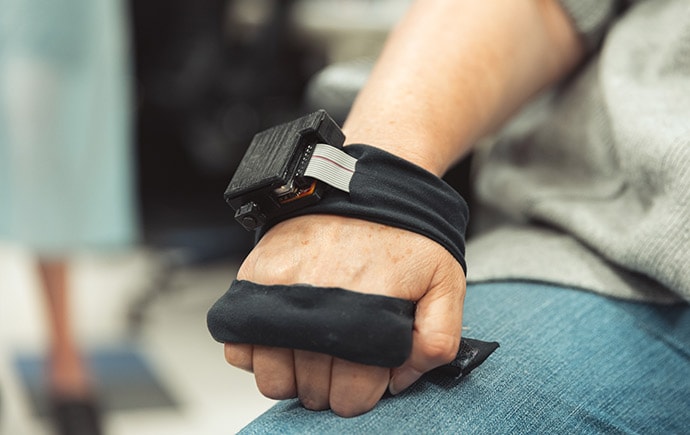A new and deceptively simple advance in chronic stroke treatment could be a vibrating glove.
Researchers at Stanford University and Georgia Tech have developed a wearable device that straps around the wrist and hand, delivering subtle vibrations (akin to a vibrating cellphone) that may relieve spasticity as well as or better than the standard Botox injections.
“The vibro-tactile stimulation can be used at home, and we’re hoping it can be relatively low cost,” said senior study author Allison Okamura, PhD, a mechanical engineer at Stanford University, Stanford, California.
For now, the device is available only to clinical trial patients. But the researchers hope to get the glove into — or rather onto — more patients’ hands within a few years. A recent grant from the National Science Foundation’s Convergence Accelerator program could help pave the way to a commercial product. The team also hopes to expand access in the meantime through larger clinical trials with patients in additional locations.
The work builds on accumulating research exploring vibration and other stimulation therapies as treatments for neurological conditions. Other vibrating gloves have helped reduce involuntary movement for patients with Parkinson’s. And the University of Kansas Medical Center, Kansas City, Kansas, will soon trial the Food and Drug Administration-approved vagal nerve stimulator, an implantable device intended to treat motor function in stroke survivors. Okamura noted that devices use “different types of vibration patterns and intensities,” depending on the disease state they target.
 The device delivers vibro-tactile stimulation — subtle vibrations, akin to a vibrating cell phone — to the fingers, hand, and wrist.
The device delivers vibro-tactile stimulation — subtle vibrations, akin to a vibrating cell phone — to the fingers, hand, and wrist.
Spasticity often develops or worsens months after a stroke. By then, patients may have run out of insurance coverage for rehabilitation. And the effectiveness of Botox injections can “wear out over time,” Okamura said.
In a clinical trial, patients wore the device for 3 hours a day for 8 weeks, while doing their usual activities. The researchers continued testing their spasticity for 2 more weeks. Symptom relief continued or improved for some patients, even after they stopped using the device. More than half of the participants experienced equal or better results than another group that only received regular Botox injections.
How Vibro-Tactile Stimulation May Rewire the Brain
The device originated at Georgia Tech, where Okamura’s postdoctoral research fellow Caitlyn Seim, PhD, was using vibro-tactile stimulation (VTS) to teach people skills, such as playing the piano, using touch-feedback training. The team decided to target spasticity, which VTS had helped in previousstudies of in-clinic (non-wearable) devices.
How does the device work? The researchers point to neuroplasticity, the ability of neurons to create new synapses or strengthen existing ones in the brain.
“The stimulation is sending additional sensory signals to the brain, which helps the brain interpret and reconnect any lost circuits,” Okamura said.
Spasticity is driven by “an imbalance in the excitatory drive to the muscles,” she continued. This can lead to worsening contractions, until a hand closes into a fist or a foot curls up. (The team has also done preliminary research on a similar device for foot spasticity, which they hope to continue developing.) Previous studies by Okamura and others suggest that vibration stimulation may prevent these contractions, both in the short and long term.
“Immediately, we do see some softening of the muscles,” Okamura said. “But in our longer-term study, where we compared to Botox, I also think that the vibration may be retraining the brain to send inhibitory signals. And that can restore balance that’s lost due to the damaged neural circuits from a stroke.”
When the team did a separate study comparing the effects of muscle and skin stimulation, they hypothesized that the vibration could be having a biomechanical effect on the muscle. Instead, they found that stimulating the skin had a greater impact — a “somewhat unexpected” result, Okamura said. That led them to the brain.
“Stimulating the skin is really about creating sensory signals that get sent to the brain,” Okamura said, “which is why we think it’s actually a brain-retraining effect and not a direct biomechanical effect.”
What’s Next?
The researchers are seeking funding for longer-term clinical studies to find out if effects persist beyond 2 weeks. They also want to explore how long and often patients should wear the glove for best results.
The researchers also want to study how movement might enhance the effects of the device.
“One of the treatments for spasticity — medications aside, this vibration machine aside — is more exercise, more passive range of motion,” said Oluwole Awosika, MD, associate professor at the University of Cincinnati College of Medicine, Cincinnati, Ohio, who was not involved in the study. “It would have been nice to have a control group that didn’t get any of this stimulation or that was only encouraged to do 3 hours of movement a day. What would the difference be?”
Awosika also wondered how easy it would be for stroke patients without in-home assistance to use the device. “Sometimes wearing these devices requires someone to put it on,” he said.
Of course, if all goes well, patients wouldn’t have to deal with that forever. “The dream would be that you reach true rehabilitation, which is no longer needing the device,” Okamura said.
>>> Read full article>>>
Copyright for syndicated content belongs to the linked Source : Medscape – https://www.medscape.com/viewarticle/promising-new-wearable-could-retrain-brain-after-stroke-2024a100044f































